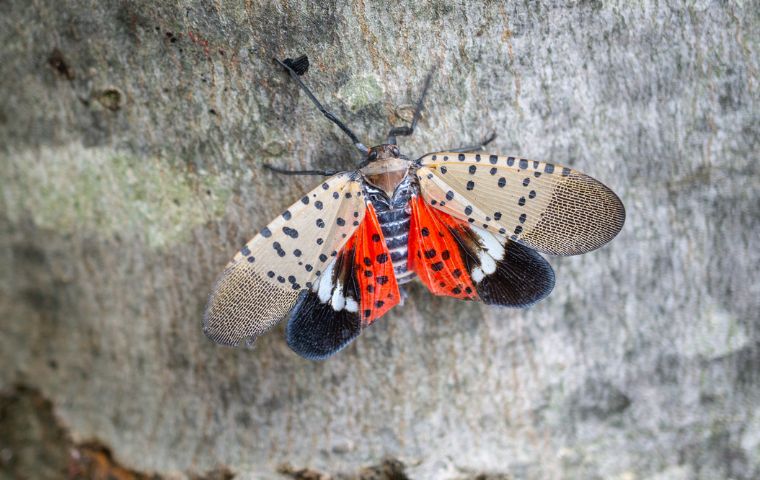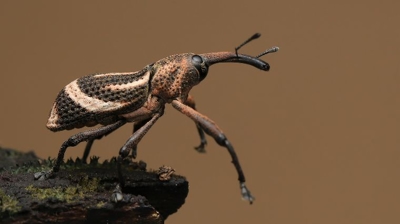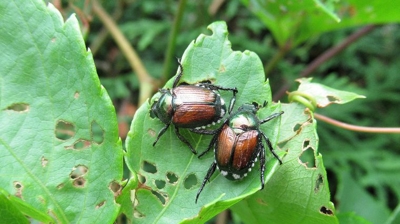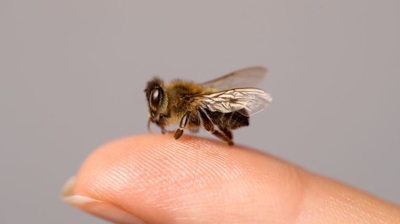
Spotted Lanternflies
What Are Spotted Lanternflies?
Spotted lanternflies (Lycorma delicatula) are invasive insects that belong to the family Fulgoridae. These insects are native to Southeast Asia, but they have become a significant invasive pest in the United States and other parts of the world. Spotted lanternflies are known for their distinctive appearance. Adult lanternflies are about one inch long and have a pair of wings that are grayish with black spots and a bright red underwing. The nymphs, on the other hand, are smaller, black with white spots, and they undergo several molts before reaching adulthood.
These insects are a serious concern because they feed on a wide range of plants, including fruit trees, ornamental plants, and hardwood trees. They use their piercing-sucking mouthparts to extract sap from these plants, which can weaken them and make them more susceptible to diseases. Additionally, spotted lanternflies excrete a sugary substance called honeydew, which can attract ants and promote the growth of sooty mold, further harming plants.
Spotted lanternflies have the potential to cause significant economic and environmental damage. They are known to threaten agriculture, particularly the grape and hardwood industries, and they can disrupt ecosystems by outcompeting native species. Efforts to control and manage these invasive pests have been ongoing, including the use of insecticides, tree banding, and biological control methods. Public awareness and reporting of spotted lanternfly sightings are crucial for tracking and managing their spread.
Are Spotted Lanternflies Harmful?
Spotted lanternflies (Lycorma delicatula) are highly invasive pests that pose significant threats to agriculture, ecosystems, and even human infrastructure. Here are some of the ways they are considered harmful:
Agricultural and Economic Damage
- Vineyards & Wineries: They are particularly destructive to grapevines, feeding on the sap and weakening the plants, which can result in lower yields and even plant death. This is a major concern for the wine industry.
- Orchards & Fruit Trees: They also attack apple, peach, and other fruit trees, reducing fruit quality and yield.
- Forestry & Timber Industry: They feed on hardwood trees such as maples, walnuts, and willows, weakening them over time and making them more vulnerable to disease and environmental stress.
- Hops & Other Crops: They also target hops, affecting beer production, and damage crops like soybeans and other ornamental plants.
Environmental and Ecological Impact
- Tree Stress & Decline: The feeding activity of spotted lanternflies weakens trees, making them susceptible to secondary infections from fungi and other pests.
- Honeydew & Sooty Mold: Their feeding produces a sugary excretion called honeydew, which promotes the growth of black sooty mold. This mold can cover leaves, blocking sunlight and reducing photosynthesis, ultimately harming plant health.
Nuisance to People and Communities
- Infestations in Public Areas: Swarms of spotted lanternflies can gather in parks, backyards, and gardens, creating an unpleasant experience for residents.
- Excessive Honeydew Secretion: This sticky substance coats outdoor furniture, vehicles, sidewalks, and decks, making surfaces dirty and attracting stinging insects like wasps and ants.
- Impact on Tourism & Outdoor Activities: Areas with heavy infestations may see reduced tourism, particularly in places known for vineyards, orchards, or scenic tree-lined spaces.
Transportation and Spread
- Hitchhiking Behavior: Spotted lanternflies lay egg masses on cars, trucks, trains, firewood, and outdoor equipment, allowing them to spread quickly to new areas. This has made containment efforts difficult.
- Regulatory Costs: Infestations lead to quarantines and increased regulatory costs for businesses transporting goods from affected areas, particularly in agriculture and landscaping industries.
Impact on Native Species
- Disrupting Food Chains: They compete with native insects for plant resources and disrupt ecosystems by altering the balance of plant and insect populations.
- Tree of Heaven (Ailanthus altissima) Proliferation: Although spotted lanternflies prefer this invasive tree, their presence does not control it effectively. Instead, they help it spread by attracting attention away from the need for its removal.
The spotted lanternfly is a major agricultural pest with far-reaching consequences. Its rapid spread threatens vital industries, disrupts ecosystems, and creates headaches for homeowners and businesses alike. Efforts to control its population involve quarantine measures, public awareness campaigns, and biological control research to mitigate its impact before it becomes an even greater issue.
Learn more: Do Lanternflies Bite?
Spotted Lanternfly Appearance
Spotted lanternflies (Lycorma delicatula) exhibit distinct and easily recognizable physical characteristics at different stages of their life cycle. Here is what they look like:
Adult Spotted Lanternflies:
- Adult spotted lanternflies are approximately one inch (2.5 cm) in length.
- They have a pair of wings with a grayish background color and are adorned with black spots.
- When their wings are closed, a vibrant red color is visible on the lower part of the wings.
- The forewings have contrasting black spots that are distributed irregularly, with some spots forming a partial pattern.
- Their hindwings are brightly colored and display a bold, contrasting pattern of black blocks and patches on a red background.
Spotted Lanternfly Nymphs:
- Nymphs go through several developmental stages, each with a distinct appearance.
- Early nymphs are small and black, usually with white spots.
- As they grow, they develop larger white spots on their black bodies, and their appearance becomes more contrasting.
These striking and conspicuous features make spotted lanternflies relatively easy to identify. Their vivid coloration and unique markings are among the key traits that help distinguish them from other insects. It's important to be able to recognize them to aid in their control and management, especially since they are considered invasive pests in various regions.
Spotted Lanternfly Habitat
Spotted lanternflies (Lycorma delicatula) are adaptable insects that can be found in a variety of habitats. They have a preference for certain host plants, which can influence their habitat selection. Here are the types of habitats where you might encounter spotted lanternflies:
- Forests: Spotted lanternflies can be found in wooded areas, particularly those containing their preferred host trees like oak and walnut. They tend to infest these trees, which are common components of forest ecosystems.
- Orchards and Vineyards: These insects are known to be damaging pests in orchards, where they feed on fruit trees such as apple, peach, and cherry. They can also infest vineyards, affecting grapevines.
- Urban and Suburban Areas: Spotted lanternflies are highly adaptable to human-altered environments. They can be found in and around residential areas, parks, and gardens. In these settings, they often target ornamental plants and trees.
- Agricultural Land: Beyond orchards and vineyards, spotted lanternflies can infest other crops, including agricultural crops such as soybeans and corn. This poses a significant threat to agriculture.
- Transportation Corridors: Spotted lanternflies can be unintentionally transported via vehicles and cargo. They are known to congregate on vehicles, making highways, railways, and shipping hubs potential locations for their spread.
- Wooded Edges: They often infest areas where woodlands meet open fields or developed areas, as they can feed on the trees in the forest and then move into nearby fields and gardens.
- Riparian Zones: Spotted lanternflies can also be found near streams, rivers, and other water bodies, as they may be attracted to the moisture and the vegetation found in riparian habitats.
Understanding the diverse habitats in which spotted lanternflies can be found is crucial for monitoring and managing their populations, especially in regions where they are invasive pests. Early detection and control measures are important to prevent their spread and mitigate the damage they can cause to various ecosystems and industries.
Spotted Lanternfly Diet
Spotted lanternflies (Lycorma delicatula) are known to be polyphagous, meaning they feed on a wide range of plant species. Their feeding habits can have a significant impact on agriculture, forestry, and the environment. Here's a list of some of the plants that spotted lanternflies might eat:
- Tree Species: Ailanthus (Tree of Heaven - this is one of their preferred host trees), oak, walnut, maple, poplar, willow, pine, apple, and cherry.
- Ornamental Plants: Roses, lilacs, azaleas, rhododendrons, wisteria, and a variety of flowering shrubs and plants.
- Agricultural Crops: Grapes (a significant concern for vineyards), apples, peaches, plums, nectarines, cherries, apricots, blueberries, peppers, soybeans, and corn.
- Hardwood and Softwood Trees: Spotted lanternflies can also damage hardwood and softwood trees in forests, making them a concern for forestry.
- Miscellaneous Plants: While they have preferred host plants, spotted lanternflies have been observed feeding on a wide variety of other vegetation, and their dietary preferences can vary by region.
Spotted lanternflies use their piercing-sucking mouthparts to extract sap from these plants. This feeding can weaken the plants, making them more susceptible to diseases and other stressors. The honeydew excreted by spotted lanternflies can also attract other insects and promote the growth of sooty mold, which further harms the plants. The broad range of plants they feed on is a significant concern, as it makes them a potential threat to a variety of industries and ecosystems. Efforts to control and manage their populations are ongoing to mitigate their impact.
Learn more: What Do Lanternflies Eat?
Spotted Lanternfly Life Cycle
The life cycle of spotted lanternflies (Lycorma delicatula) involves several distinct stages, each with its own characteristics. Understanding their life cycle is important for effective management and control. Here is an overview of the spotted lanternfly life cycle:
Egg Stage:
- Spotted lanternflies start their life cycle as eggs.
- Eggs are laid in late summer or early fall, typically on smooth surfaces, such as tree trunks, rocks, or outdoor furniture.
- The eggs are laid in masses, covered with a gray, putty-like substance, which hardens over time and protects the eggs through the winter.
Nymph Stage:
- In spring, the eggs hatch, giving rise to nymphs.
- The nymphs go through four instar stages, during which they undergo gradual development.
- Early nymphs are small, black, and have white spots.
- As they progress through instar stages, they become larger and develop red patches.
Nymphs actively feed on plant sap during this stage.
Adult Stage:
- After completing the nymphal stages, spotted lanternflies become adults, usually in late summer.
- Adult lanternflies have a distinct appearance: they are about one inch in length, with grayish wings adorned with black spots.
- Their hindwings display a striking red and black pattern when opened.
Reproduction:
- During the adult stage, spotted lanternflies reproduce, laying eggs for the next generation.
- Mating usually occurs in late summer and early fall.
- Females lay egg masses, as described in the egg stage, to overwinter and continue the cycle.
The spotted lanternfly life cycle is a key factor contributing to their potential for rapid population growth. Their ability to reproduce and spread is a concern for agriculture and ecosystems, as they feed on a wide variety of plants, including economically important crops. Effective management strategies often target the egg masses and nymphs to prevent their proliferation and limit the damage they can cause. Early detection and control measures are essential to mitigate their impact in affected regions.

Hear From Our Happy Customers
-
"Exceeds Expectations"
I can’t say enough positive things about this company... The tech that came out, Jarvis went above and beyond my expectations. Thank you guys, I will continue using your services.
- Jake M. -
"Great Communication"
Tech was on time, communication was great, and he accommodated my needs.
- Alonzo W. -
"Very Knowledgeable"
The tech that arrived was courteous, professional, and very knowledgeable. He was Great.
- Uerial I. -
"Professional & Considerate"
I’m pleased with Miche services. Jarvis came today. Professional and considerate. Thank you!
- Judy B. -
"Fantastic & Patient"
Jarvis was fantastic and patient. He answered my questions with an in-depth explanation and addressed all of my areas of concern. Would love for him to be my assigned tech going forward. Well done!
- Yonnette M. -
"Wonderful Service"
Wonderful service. Jarvis is great. Took care of everything I needed. Thank you!
- Henry P.



